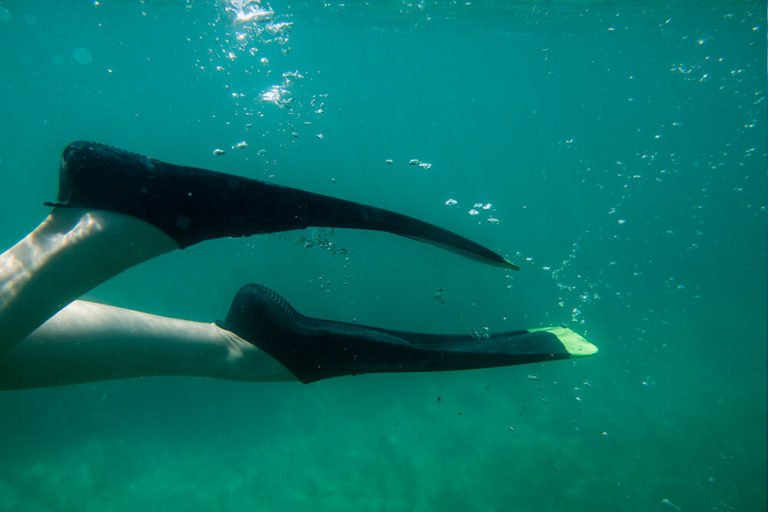Deep Dive: How to Swim with Fins

Swimming with fins… well, let’s just say it’s harder than it looks. Luckily, the fish don’t judge, but swimming skillfully can help keep you stay safe and save air consumption underwater. The more you practice, the more your fins will work for you (not the other way around).
START IN THE POOL
First time with fins? Practice in the pool before you take the plunge into the ocean. Since fins are responsible for your movements underwater, they can make all the difference. We recommend finding fins with either short or elliptical blades. These fins are more efficient, which decreases energy use—and in turn, air. Then, make sure they fit snug without hurting. And, be sure to put on your new fins before you get in the water.
GET YOUR KICKS
It’s all about finding balance with your fins. As you swim, you’ll want to keep your legs straight but relaxed (don’t lock your knees or ankles). Start with small kicks, gently moving your feet. You’ll notice you can propel forward without much effort. Once you feel comfortable, kick a little harder. The more you feel your fins, the more energy you’re using. The goal is to find fins that work for you, so you can save energy, decrease oxygen consumption, and increase your bottom time. If you find yourself feeling short of breath easily, try to switch out your fins for a more efficient pair. And we always recommend training in the pool to build up your stamina.
LEARN DIFFERENT FIN TECHNIQUES
When diving, you can use different kicks in different destinations to increase efficiency and decrease physical fatigue. After all, the rate of your breathing and your air consumption is directly related to your kicking style. The three kicks you should know are: flutter kicks, frog kicks, and bent-knee cave diver kicks.
THE FLUTTER KICK
The flutter kick is the most basic technique divers use, because it’s the strongest. You should use it when you’re swimming against a current or wall diving. But, be cautious flutter kicking when you’re close to a loose bottom because you can kick up silt.
THE FROG KICK
The frog kick is wider and bigger than the flutter kick. It helps you maintain your buoyancy and decrease air consumption. It’s a great technique when you’re gliding through the water and exploring.
THE BENT-KNEE CAVE DIVER KICK
The bent-knee cave diver kick (don’t worry, it’s not as tricky as it sounds) is the go-to technique for divers because it causes the least amount of disturbance. The bent knees means the movement is limited, which causes less strain and air consumption. It’s best used in caves or other cramped areas because it won’t bring up as much silt.
GO FROM BEGINNER TO MASTER
When it comes to scuba diving, it’s all in the technique. The more you practice, the more you’ll become better at analyzing your environment and using the appropriate kick. Before you know it, you’ll be less flop and more flutter.
